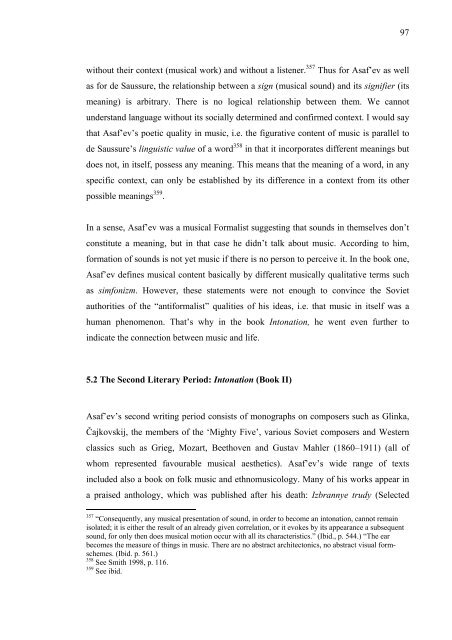Boris Asaf'ev and the Soviet Musicology - E-thesis
Boris Asaf'ev and the Soviet Musicology - E-thesis
Boris Asaf'ev and the Soviet Musicology - E-thesis
Create successful ePaper yourself
Turn your PDF publications into a flip-book with our unique Google optimized e-Paper software.
without <strong>the</strong>ir context (musical work) <strong>and</strong> without a listener. 357 Thus for Asaf’ev as well<br />
as for de Saussure, <strong>the</strong> relationship between a sign (musical sound) <strong>and</strong> its signifier (its<br />
meaning) is arbitrary. There is no logical relationship between <strong>the</strong>m. We cannot<br />
underst<strong>and</strong> language without its socially determined <strong>and</strong> confirmed context. I would say<br />
that Asaf’ev’s poetic quality in music, i.e. <strong>the</strong> figurative content of music is parallel to<br />
de Saussure’s linguistic value of a word 358 in that it incorporates different meanings but<br />
does not, in itself, possess any meaning. This means that <strong>the</strong> meaning of a word, in any<br />
specific context, can only be established by its difference in a context from its o<strong>the</strong>r<br />
possible meanings 359 .<br />
In a sense, Asaf’ev was a musical Formalist suggesting that sounds in <strong>the</strong>mselves don’t<br />
constitute a meaning, but in that case he didn’t talk about music. According to him,<br />
formation of sounds is not yet music if <strong>the</strong>re is no person to perceive it. In <strong>the</strong> book one,<br />
Asaf’ev defines musical content basically by different musically qualitative terms such<br />
as simfonizm. However, <strong>the</strong>se statements were not enough to convince <strong>the</strong> <strong>Soviet</strong><br />
authorities of <strong>the</strong> “antiformalist” qualities of his ideas, i.e. that music in itself was a<br />
human phenomenon. That’s why in <strong>the</strong> book Intonation, he went even fur<strong>the</strong>r to<br />
indicate <strong>the</strong> connection between music <strong>and</strong> life.<br />
5.2 The Second Literary Period: Intonation (Book II)<br />
Asaf’ev’s second writing period consists of monographs on composers such as Glinka,<br />
Čajkovskij, <strong>the</strong> members of <strong>the</strong> ‘Mighty Five’, various <strong>Soviet</strong> composers <strong>and</strong> Western<br />
classics such as Grieg, Mozart, Beethoven <strong>and</strong> Gustav Mahler (1860–1911) (all of<br />
whom represented favourable musical aes<strong>the</strong>tics). Asaf’ev’s wide range of texts<br />
included also a book on folk music <strong>and</strong> ethnomusicology. Many of his works appear in<br />
a praised anthology, which was published after his death: Izbrannye trudy (Selected<br />
357<br />
“Consequently, any musical presentation of sound, in order to become an intonation, cannot remain<br />
isolated; it is ei<strong>the</strong>r <strong>the</strong> result of an already given correlation, or it evokes by its appearance a subsequent<br />
sound, for only <strong>the</strong>n does musical motion occur with all its characteristics.” (Ibid., p. 544.) “The ear<br />
becomes <strong>the</strong> measure of things in music. There are no abstract architectonics, no abstract visual formschemes.<br />
(Ibid. p. 561.)<br />
358<br />
See Smith 1998, p. 116.<br />
359<br />
See ibid.<br />
97

















